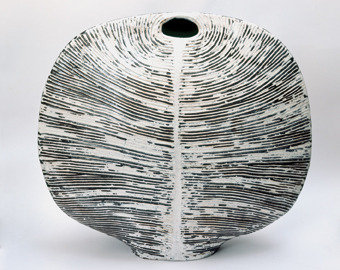Two exhibitions
dal 25/4/2012 al 8/6/2012
Segnalato da
Caroline Achaintre
Gordon Baldwin
Ken Eastman
Edith Garcia
Nicholas Lees
Martin Smith
Robert Adams
25/4/2012
Two exhibitions
Gimpel Fils, London
Uniting art, design, sculpture and craft, James Tower holds a unique position in the history of British ceramics. On show also Caroline Achaintre, Gordon Baldwin, Ken Eastman, Edith Garcia, Nicholas Lees, Martin Smith. Robert Adams presents his late bronzes.

James Tower and Contemporary Ceramic Art
Caroline Achaintre, Gordon Baldwin, Ken Eastman, Edith Garcia, Nicholas Lees, Martin Smith
Uniting art, design, sculpture and craft, James Tower holds a unique position in the history of British ceramics. As an artist who consistently challenged the perceived limits of his medium, throughout his career Tower explored the sculptural and painterly potential of ceramic forms. His vessels, plates and sculptures are exhibited here alongside recent works by six contemporary artists in order to demonstrate that the questions he grappled with have yet to be resolved.
This exhibition explores the continuing problem of how artists who work in ceramics are classified: ceramist; sculptor; painter; artist. The relevance of these definitions is actively tested by the artists included in this exhibition, all of whom explore their ideas in multiple mediums. At Brighton Polytechnic Tower was Head of Sculpture, and yet his ceramic works were not regarded as such. Indeed, his sculptures and drawings were overlooked during his lifetime. Displaying objects and drawings together, Nicholas Lees explores what he regards as the porous membrane between ceramics and sculpture in order to demonstrate their reciprocity.
Placed side by side works by Tower, Gordon Baldwin and Ken Eastman encourage a dialogue between sculptural shape, painterly surfaces and, indeed between sculpture and vessel. Like Tower, Baldwin has utilized both sculptural form and abstract marks in his work, while Eastman’s engagement with colour, and Martin Smith’s exploration of light and surface demonstrate that to work in ceramics, is also to be a painter. The scratched designs, the striated lines and dashes over the concave or convex surfaces of Tower’s vessels and plates are indicative of his desire to create a synthesis between the form and surface.
Like his contemporaries, William Scott and Peter Lanyon, Tower sought to refine an abstracted style based on natural forms. The sea and its inhabitants provided motifs and compositional models that Tower adopted and adapted according to his artistic ideals; in Snow Forest, 1982, Tower’s use of textured surface is reminiscent of a shell, mollusc or crustacean. The universality of these natural forms find commonalities in Edith Garcia’s recent body of work Absence and Presence. In a series of pressed clay forms she considers our ability to find the human form in the most minimal of shapes, objects and natural phenomena. Caroline Achaintre has also looked to Lanyon in recent work; but her interest in modern art and its legacies defy categorical boundaries and as such might be understood as uncanny hybrids of utopian ideas and human emotions.
This exhibition coincides with the publication of The Ceramic Art of James Tower, by Timothy Wilcox, with a foreword by Antony Gormley. In association with the publisher Lund Humphries, Gimpel Fils is pleased to host a reception celebrating this outstanding monograph on Thursday 10 May, 6-8pm.
James Tower (1919-1988) had his first solo exhibition at Gimpel Fils in 1951, having previously studied at the Royal Academy Schools and the Slade. During the 1960s and 70s, he was Head of Pottery at the Bath Academy of Art in Corsham, and Head of Sculpture at Brighton Polytechnic. Work by James Tower can be found in numerous public and private collections, including the Victoria and Albert Museum, London; The Sainsbury Centre for Visual Arts, Norwich; the Harris Museum, Preston; the South East Arts Crafts Collection, Hove and Art Institute of Chicago.
----
Also Showing:
Robert Adams Late Bronzes
26 April – 9 June 2012
Private View: Thursday 26 April, 6-8pm
Gimpel Fils
30 Davies Street - London
Gallery hours: Mon - Fri 10am - 5.30pm, Sat 11am - 4pm
Free admission



